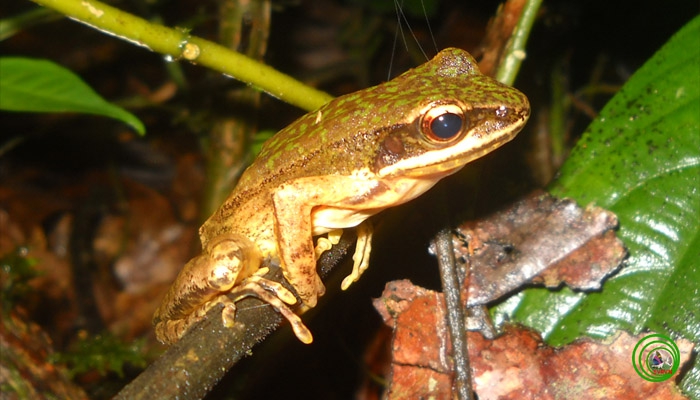| Citation |
|
Description |
Geographic Range [top]
Range Description: This species is currently known only from 600–1,500 m Asl in Khammouan Province, Laos, and both Kon Tum and Quang Nam Provinces, Viet Nam (Bain et al. 2006, Jodi Rowley unpubl. data). Such disjunct localities are unlikely to represent the actual limits of the species range as similar habitat and elevations to those in its known localities occur throughout the intervening Central Highlands of Viet Nam and Southern Highlands of Laos, as well as a small section of eastern Cambodia. Further surveys may uncover its presence in these areas, therefore its range has been projected beyond known sites to include areas of suitable habitat. The speciesextent of occurrence (EOO) is 75,843 km2, which represents six threat-defined locations.
Countries occurrence:
Native:
Lao Peoples Democratic Republic; Viet Nam
Additional data:
? Number of Locations: 6
? Lower elevation limit (metres): 600
? Upper elevation limit (metres): 1500
Range Map: Click here to open the map viewer and explore range.
Population [top]
Population: The size of this species population is not well known, however it has been detected in few surveys (Jodi Rowley unpubl. data, Bain et al. 2006 and Stuart 1999 – as Rana archotaphus), and described as uncommon in Viet Nam (Jodi Rowley pers. comm. December 2015). It is likely that ongoing forest loss associated with expanding agriculture throughout Southeast Asia (Meyfroidt and Lambin 2008, Sodhi et al. 2009, Meyfroidt et al. 2013) is causing some population declines.
Current Population Trend: Decreasing
Additional data:
Habitat and Ecology [top]
Habitat and Ecology: This species is closely associated with streams and cascades in evergreen forest and has been observed on river banks, rocks, and in herbaceous vegetation (Bain et al. 2006). Reproductive behaviour including males calling and pairs in amplexus has been observed during September and November in Viet Nam and Laos, respectively (Bain et al. 2006). Males call from rocks and bushes close to cascades (Bain et al. 2006). Much of the species reproductive biology is unknown, however it presumably breeds in streams by larval development, as with other Amolops for which the reproductive strategy is known. This species has not been reported from disturbed areas, but the quality of habitat within much of its range appears to be in decline due to agriculture (Meyfroidt and Lambin 2008, Sodhi et al. 2009, Meyfroidt et al. 2013).
Systems: Terrestrial; Freshwater
Continuing decline in area, extent and/or quality of habitat: Yes
Movement patterns: Not a Migrant
Use and Trade [top]
Use and Trade: There are no reports of this species being utilized.
Threats [top]
Major Threat(s): Habitat loss and degradation due to rapidly expanding agriculture is an ongoing threat to biodiversity throughout Southeast Asia (Sodhi et al. 2009). In the Central Highlands of Viet Nam large areas of forest are converted to agricultural land to grow cash crop plantations (e.g. rubber, coffee and tea) (Meyfroidt and Lambin 2008, Meyfroidt et al. 2013). High rates of agricultural encroachment on natural forest are also causing ongoing deforestation in much of Laos and Cambodia (Sodhi et al. 2009). Other causes of habitat loss in Cambodia are logging, hydroelectric dams, and increasing human settlements, all of which are ongoing within protected areas (Bottomley 2000, Ohler et al. 2002, Conservation International 2007, Grimsditch 2012). As a result, this species is very likely threatened to some degree by habitat loss.
Conservation Actions [top]
Conservation Actions: Conservation Actions
This species is known from Nakai-Nam Theun National Biodiversity Conservation Area in Laos (Bain et al. 2006). A considerable number of other protected areas are included in parts of this species predicted range; it very likely occurs in some of these also.
Conservation Needed
In order to ensure the species long-term survival, the lack of data must be addressed.
Research Needed
Research should be carried out to determine its relative abundance, life history, and threats.
Citation: IUCN SSC Amphibian Specialist Group. 2017. Amolops compotrix. The IUCN Red List of Threatened Species 2017: e.T136153A87952652. http://dx.doi.org/10.2305/IUCN.UK.2017-2.RLTS.T136153A87952652.en. Downloaded on 19 October 2018.
Disclaimer: To make use of this information, please check the .
Feedback: If you see any errors or have any questions or suggestions on what is shown on this page, please provide us with feedback so that we can correct or extend the information provided
|

